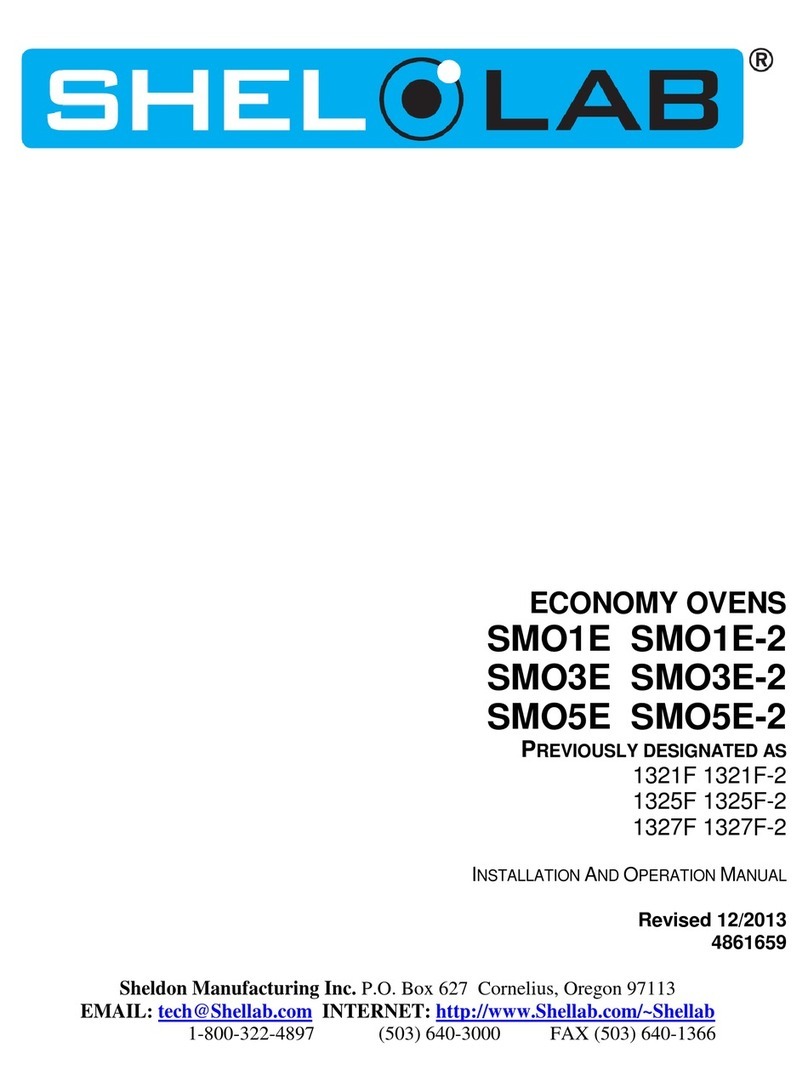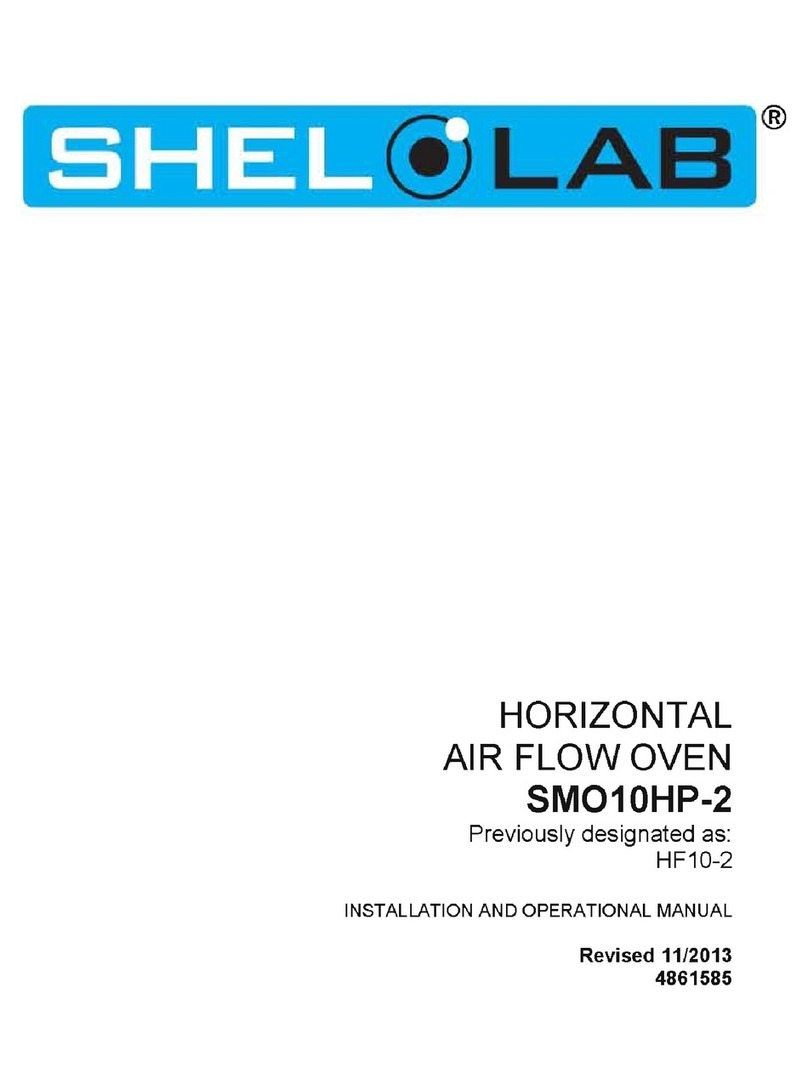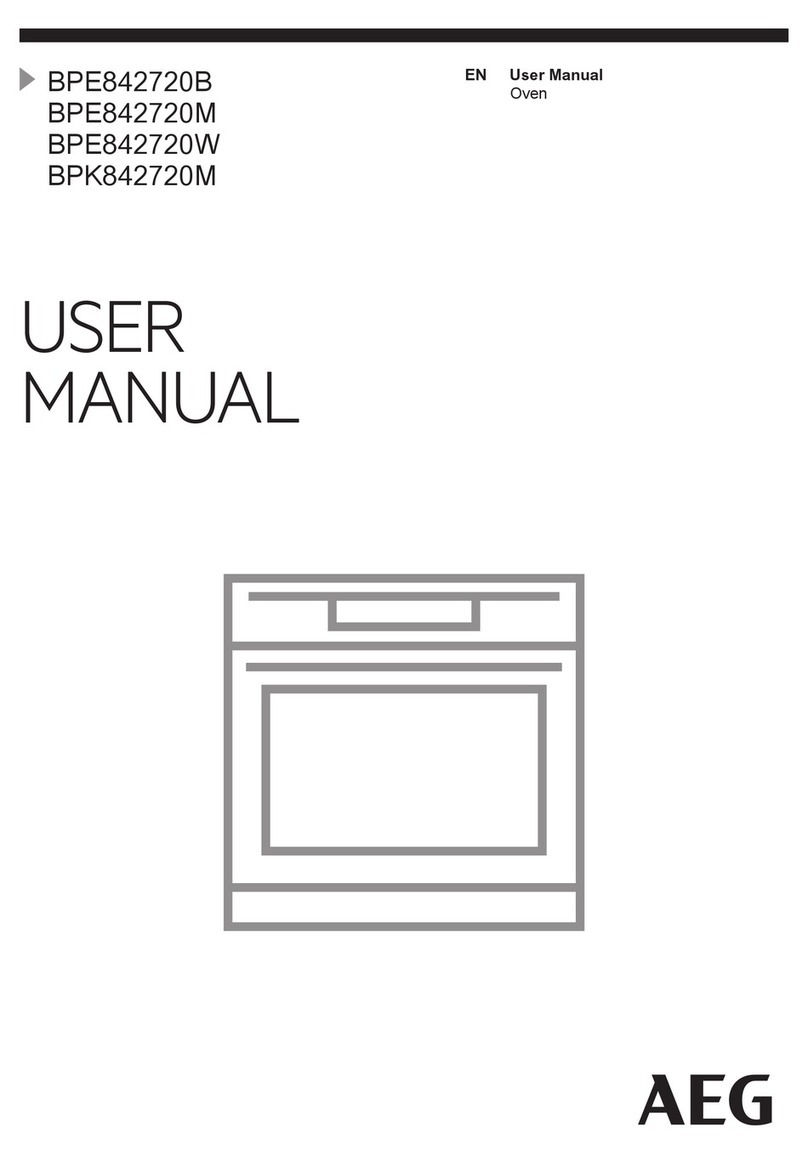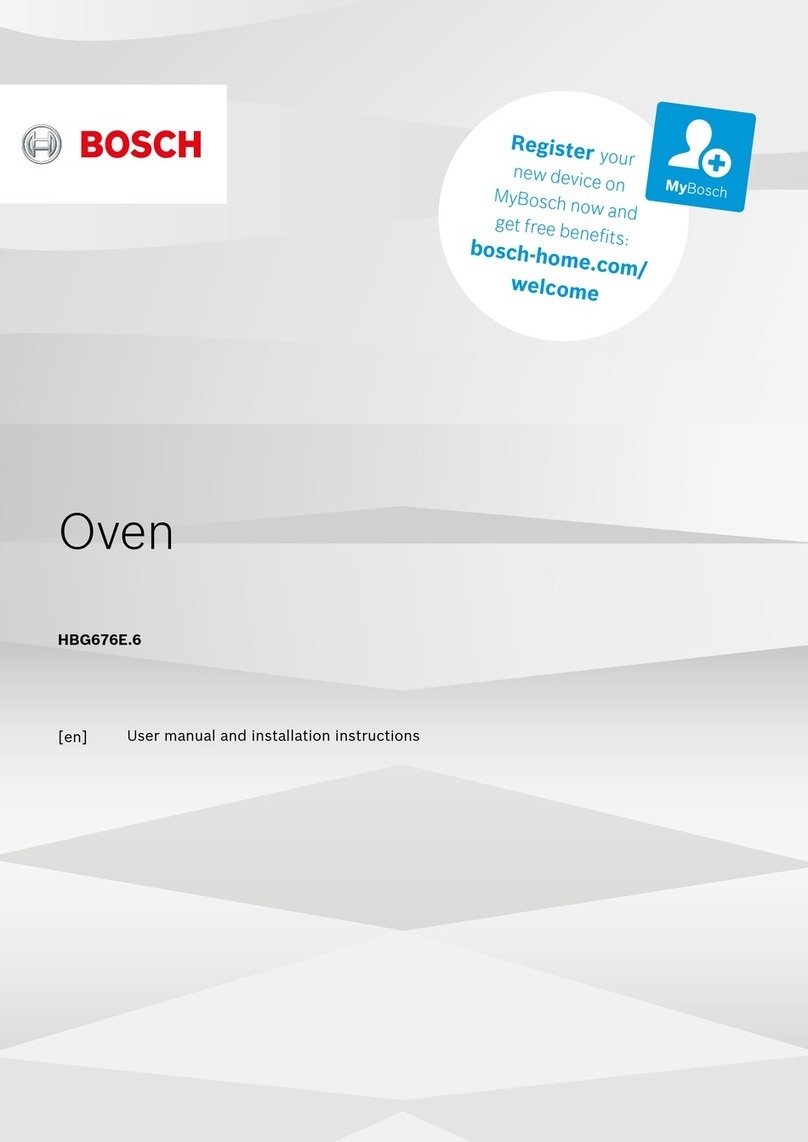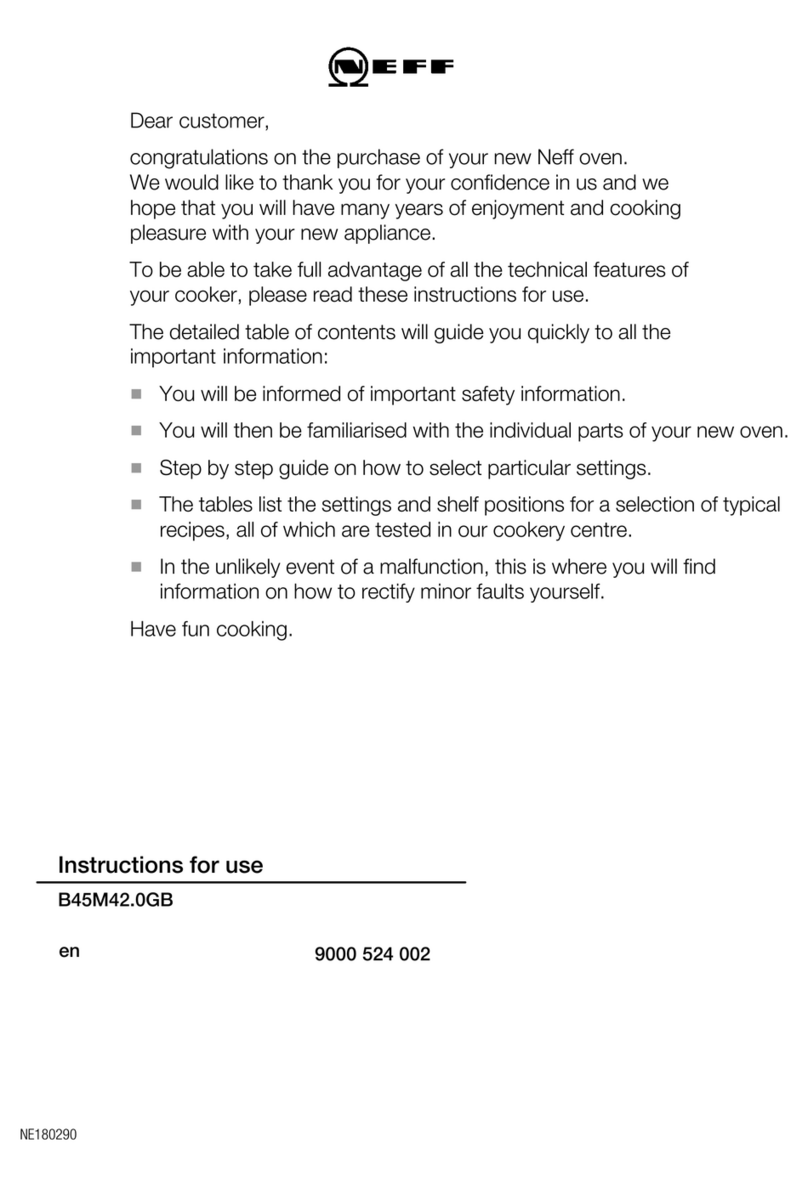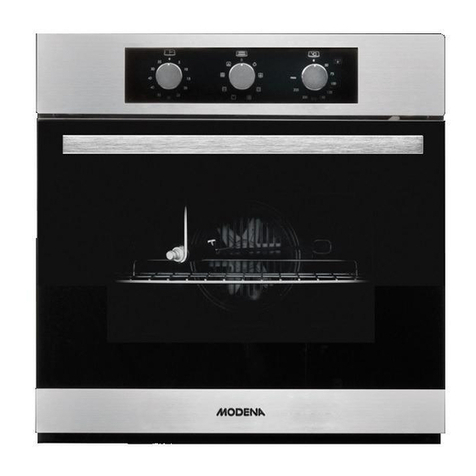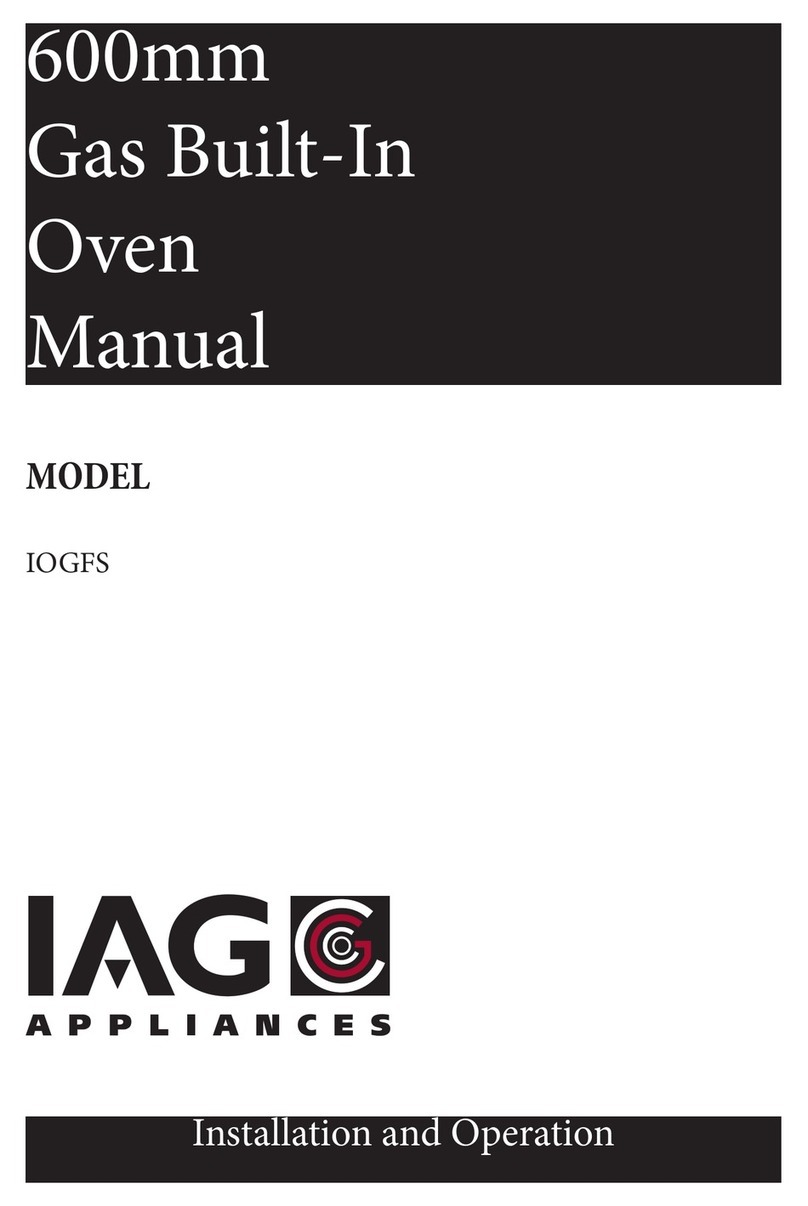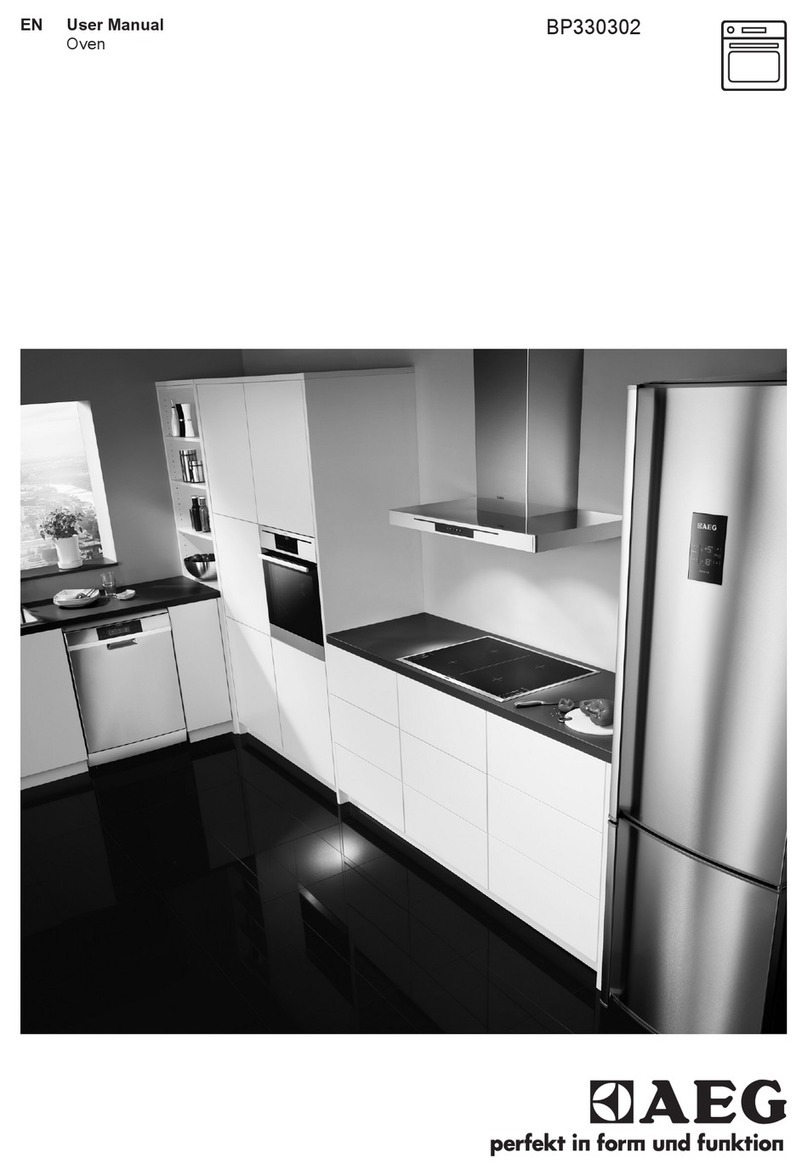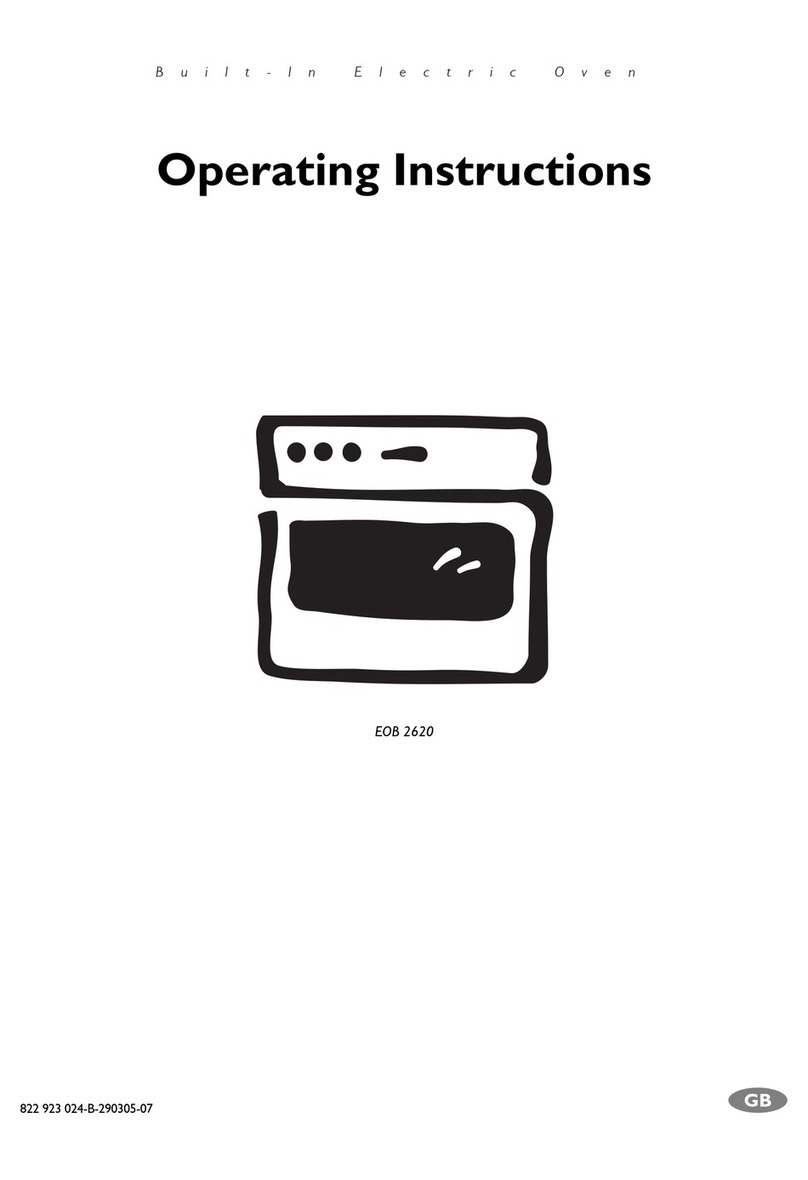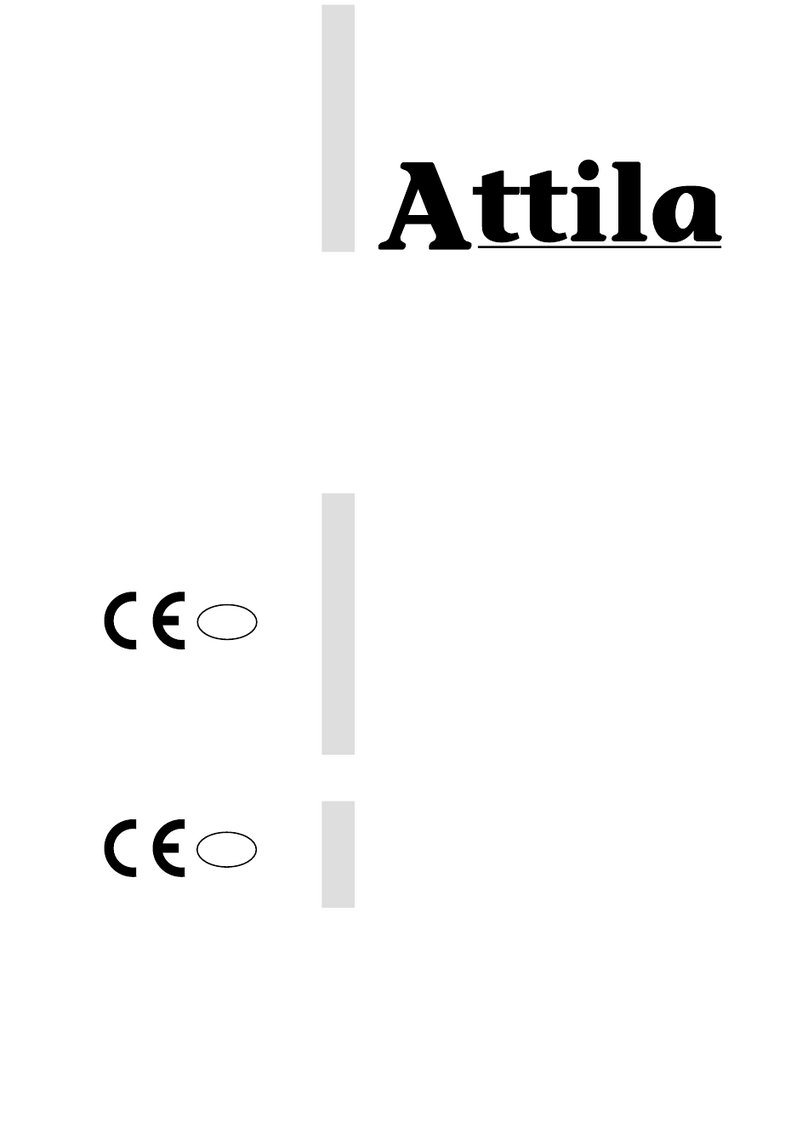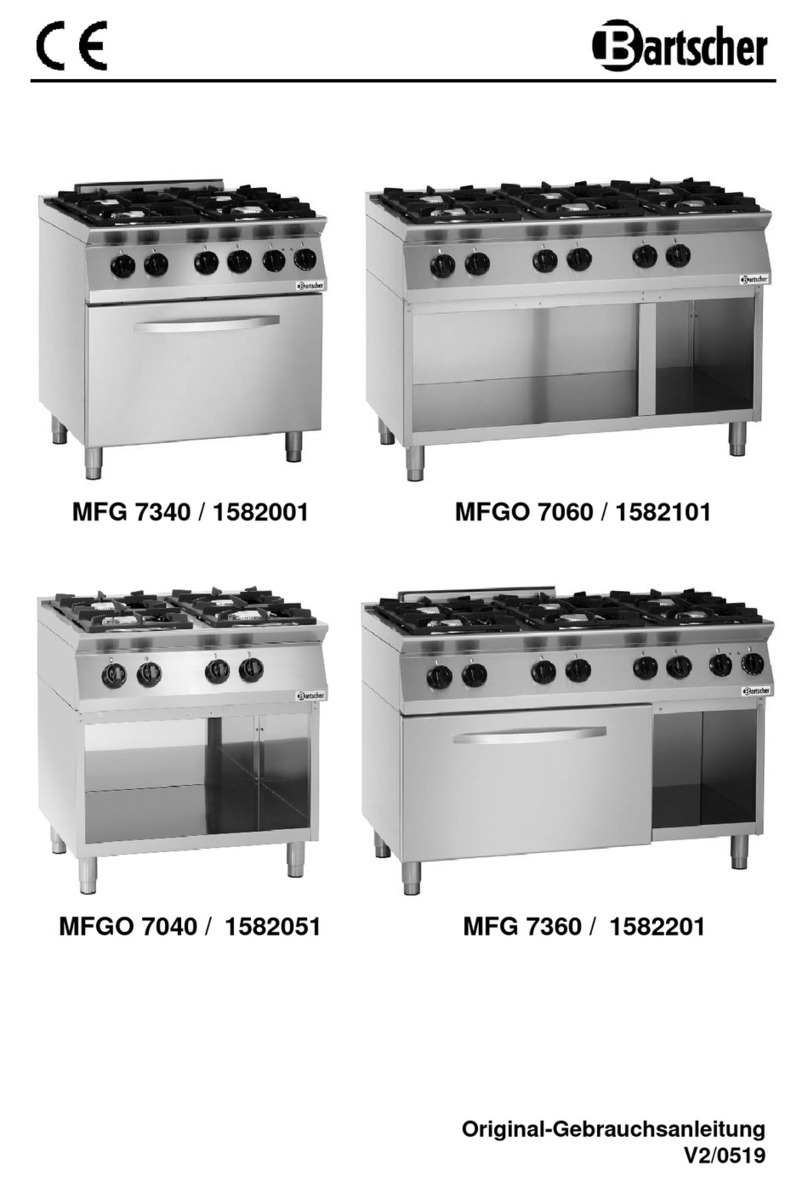shelolab SMO34HP-2 User manual

Installation and
Operation Manual
SMO34HP-2, SMO38HP-2
SMO14HP-2, SM10HP-2
Previously Designated:
HF25-2, HF37-2, HF15-2, HF10-2
SMO HIGH PERFORMANCE OVENS
220 - 240 Voltage

2 | P a g e
SMO High Performance Ovens 220 - 240 Voltage
Large Capacity
Installation and Operation Manual
Part number (Manual): 4861705
Revision: December 14, 2015
These ovens do not plug into a wall using a conventional plug. These ovens require
permanent connect wiring (also known as hardwiring).
Pictured on front cover, left to right: SMO34HP-2, SMO38HP-2, SMO14HP-2
These units are TÜV CUE listed as forced air ovens for professional, industrial, or educational use
where the preparation or testing of materials is done at an ambient air pressure range of 22.14 –
31.3 inHg (75 –106 kPa) and no flammable, volatile, or combustible materials are being heated.
The units have been tested to the following requirements:
CAN/CSA C22.2 No. 61010-1:2012
CAN/CSA C22.2 No. 61010-2-010:2004 Reaffirmed: 2014-07
UL 61010-1:2012-05
UL 61010A-2-010:2002-03
EN 61010-1:2010
EN 61010-2-010:2014
Supplemented by: UL 61010-2-010:2015
SMO10HP-2

3 | P a g e
TABLE OF CONTENTS
INTRODUCTION...........................................................................................................................................4
General Safety Considerations.................................................................................................................4
Engineering Improvements .......................................................................................................................5
Contacting Assistance...............................................................................................................................5
RECEIVING YOUR OVEN............................................................................................................................6
Inspecting the Shipment............................................................................................................................6
Orientation Photos.....................................................................................................................................7
Recording Data Plate Information...........................................................................................................11
Temperature Reference Sensor Device .................................................................................................11
INSTALLATION..........................................................................................................................................12
Required Ambient Conditions .................................................................................................................12
Location Considerations..........................................................................................................................12
Power Source Requirements..................................................................................................................13
Power Feed Wiring..................................................................................................................................14
Lifting and Handling ................................................................................................................................14
Leveling...................................................................................................................................................14
Install the Oven .......................................................................................................................................15
Initial Cleaning.........................................................................................................................................15
Shelving Installation ................................................................................................................................15
GRAPHIC SYMBOLS.................................................................................................................................16
CONTROL PANEL OVERVIEW.................................................................................................................18
OPERATION...............................................................................................................................................21
Operating Precautions ............................................................................................................................21
Preparing the Oven for Use ....................................................................................................................24
Prepare for First Use Burn-In..................................................................................................................24
Set the Temperature Set Point................................................................................................................25
First Use Burn In .....................................................................................................................................26
Temperature Accuracy Verification.........................................................................................................28
Set the Over Temperature Limit..............................................................................................................30
OTL Activation During Normal Operations..............................................................................................31
Programming a Heating Profile...............................................................................................................31
Positive Venting of Exhaust ....................................................................................................................32
USER MAINTENANCE...............................................................................................................................34
Cleaning and Disinfecting .......................................................................................................................34
Electrical Components ............................................................................................................................35
Door Gaskets and Chamber Integrity......................................................................................................35
Calibrate the Temperature display..........................................................................................................36
UNIT SPECIFICATIONS.............................................................................................................................40
Weight .....................................................................................................................................................40
Dimensions..............................................................................................................................................40
Capacity ..................................................................................................................................................41
Shelf Capacity by Weight........................................................................................................................41
Temperature............................................................................................................................................41
Power ......................................................................................................................................................41
REPLACEMENT PART LIST.....................................................................................................................42

4 | P a g e
INTRODUCTION
Thank you for purchasing a Sheldon Manufacturing SMO forced air, high performance oven. We
know that in today’s competitive marketplace customers have many choices when it comes to
constant temperature equipment. We appreciate you choosing ours. Our continued reputation as a
leading laboratory product manufacturer rests with you. We stand behind our products and will be
here for you if you need us.
These ovens are intended for professional, industrial, and educational applications requiring
horizontal shelf space air flows. The ovens are not designed for use at hazardous or household
locations.
GENERAL SAFETY CONSIDERATIONS
Note: Failure to follow the guidelines and instructions in this manual may create a protection
impairment by disabling or interfering with the unit’s safety features. This can result in injury
or death.
Before you use your oven read this entire manual carefully to understand how to install, operate,
and maintain the oven in a safe manner. Keep this manual available for use by all oven operators.
Ensure that all operators are given appropriate training before the oven begins service.
Your oven and its recommended accessories have been designed and tested to meet strict safety
requirements. For continued safe operation of your oven, always follow basic safety precautions
including:
Follow any local or regional ordinances in your area regarding the use of this unit.
Only use the oven for its intended range of applications.
Use only approved accessories. Do not modify system components. Any alterations or
modifications to your oven may be dangerous and will void your warranty.
Always hardwire the unit power feed to a protective earth-grounded electrical source that
conforms to national and local electrical codes. If the unit is not grounded, parts such as,
knobs and controls may conduct electricity and cause serious injury.
Avoid damaging the power feed. Do not bend it excessively, step on it, place heavy objects
on it. A damaged power feed can easily become a shock or fire hazard. Never use a power
feed after it has been damaged.
Position the equipment so the end-user can quickly and easily disconnect or uncouple the
power feed in the event of an emergency.
Do not attempt to move the unit while in operation or before the unit has cooled.

5 | P a g e
INTRODUCTION (CONTINUED)
ENGINEERING IMPROVEMENTS
Sheldon Manufacturing continually improves all of its products. As a result, engineering changes
and improvements are made from time to time. Therefore, some changes, modifications, and
improvements may not be covered in this manual. If your unit’s operating characteristics or
appearance differs from those described in this manual, please contact your Shel Lab dealer or
customer service representative for assistance.
CONTACTING ASSISTANCE
If you are unable to resolve a technical issue with the oven, please contact Sheldon Technical
Support. Phone hours for Sheldon Technical Support are 6am –4:30pm Pacific Coast Time (west
coast of the United States, UTC -8).
Please have the following information ready when calling or emailing Technical Support: the model
number and the serial number. These will be found on the unit’s data plate, which is located on
the back of the unit at the top right, next to the power supply as mandated by regulatory
requirement. See page 7.
Sheldon Manufacturing INC.
P.O. Box 627
Cornelius, OR 97113

6 | P a g e
RECEIVING YOUR OVEN
Before leaving the factory, all ovens are packaged in high-quality shipping materials to provide
protection from transportation-related damage. When a unit departs our factory, safe delivery
becomes the responsibility of the carrier. Damage sustained during transit is not covered by the
manufacturing defect warranty.
This makes it important that you inspect your oven for concealed loss or damage to its interior and
exterior when receiving it. If you find any damage to the unit, follow the carrier’s procedure for
claiming damage or loss.
The orientation photos on the immediately following pages may serve as useful references when
inspecting the oven.
Carefully check all packaging before discarding. Save the shipping carton until you are certain that
the unit and its accessories function properly.
INSPECTING THE SHIPMENT
Carefully inspect the shipping carton for damage. Report any damage to the carrier service that
delivered the SMOHP oven. If the carton is not damaged, open the carton and remove the
contents. The unit should come with an Installation and Operation Manual, and a Certificate of
Compliance.
Verify that the correct number of shelves, shelf slides, and leveling feet have been included (see
the following table for quantities).
Included accessories
Model
Shelves
Shelf Slides / Clips
Leveling Feet
SMO10HP-2
3
12 Clips
4
SMO14HP-2
6
24 Clips
4
SMO34HP-2
6
24 Clips
4
SMO38HP-2
12
48 Clips
4
Carefully check all packaging before discarding. Save the shipping carton until you are certain that
the unit and its accessories function properly.

7 | P a g e
Figure 1: SMO34HP-2
RECEIVING YOUR OVEN (CONTINUED)
ORIENTATION PHOTOS
Permanent Connect Wire Braid
6 gauge, 6 inches (15 cm)
Exhaust
Vent
Intake
Vent
Power Panel (Back)
Control Panel
Temperature
Sensor Probes
Chamber Gasket
Power Exhaust
Outlet 6-20R
Fuse Holders for External
Receptacle (2 amps each)
Chamber Ceiling Liner
Power Supply Feed
Shelf Standard Mounting
Rail

8 | P a g e
Figure 2: SMO38HP-2
RECEIVING YOUR OVEN (CONTINUED)
Power Panel
(Back)
Temperature Sensor
Probes
Chamber Ceiling Liner
Permanent Connect Wire Braid 6
gauge, 6 inches (15 cm)
Control Panel
Exhaust Vent
Intake Vent
Chamber Liner Gasket
Shelf Standard
Mounting Rail
Fuse Holders for External
Receptacle (2 amps each)
Power Exhaust
Outlet 6-20R
Power
Supply Feed

9 | P a g e
Figure 3: SMO14HP-2
RECEIVING YOUR OVEN (CONTINUED)
Intake Vent
Exhaust Vent
Control Panel
Chamber Gasket
Temperature
Sensor Probes
Chamber Ceiling Liner
Power Panel (Back)
Permanent Connect Wire Braid
10 gauge, 6 inches (15 cm)
Fuse Holders for External
Receptacle (2 amps each)
Power Exhaust
Outlet 6-20R
Power
Supply Feed
Shelf Standard Mounting Rail

10 | P a g e
RECEIVING YOUR OVEN (CONTINUED)
Shelf Standard Mounting Rail
Power Panel
(Back)
Fuse Holders for External
Receptacle (2 amps each)
Power Exhaust
Outlet 6-20R
Intake Vent
Exhaust Vent
Control
Panel
Chamber Ceiling
Liner
Door Gasket
Permanent Connect Wire Braid
10 gauge, 6 inches (15 cm)
Power
Supply Feed
Temperature
Sensor Probes
(In Chamber)
Figure 4: SMO10HP-2

11 | P a g e
RECEIVING YOUR OVEN (CONTINUED)
RECORDING DATA PLATE INFORMATION
Locate the data plate on the back of the oven next to the power inlet. The data plate contains the
oven model number and serial number. Enter this information below for future reference.
Date Plate Information
Model Number
Serial Number
TEMPERATURE REFERENCE SENSOR DEVICE
The oven does not come with a temperature reference device. A reference sensor device must be
purchased separately for performing accuracy verifications or calibrations of the oven temperature
display.
The reference device must be accurate to at least 0.1°C, and should be regularly calibrated,
preferably by a third party.
For best results, use a digital device with a thermocouple or other remote reading probe. Remote
readings avoid oven chamber door openings during verification and calibration procedures. This
avoids subsequent waits for the chamber temperature to re-stabilize. Select a probe suitable for the
application temperature you will be calibrating or verifying the display accuracy at.
Alcohol thermometers are insufficient for conducting accurate verifications and calibrations. Do not use a
mercury thermometer. Never place a mercury thermometer in the oven chamber.

12 | P a g e
INSTALLATION
Installation of a High Performance Oven requires permanent connect wiring (commonly known as
hardwiring), and must be performed by a qualified electrical technician. All other steps can be
performed by the end user.
REQUIRED AMBIENT CONDITIONS
This oven is intended for use indoors, at room temperatures between 15C and 40C (59F and
104F), at no greater than 80% Relative Humidity (at 25C / 77F). Allow a minimum of 12 inches
(30cm) between the oven and any walls or partitions, and 24 inches (60cm) of vertical headspace
clearance above the top of the oven for unobstructed airflow and cooling. If the oven exhaust will be
vented from the workspace through a duct or other channeling, 12 inches (30cm) of vertical
clearance will suffice. Make sure the intake and exhaust vent remain unobstructed. Do not place
objects on top of oven, aside from the power exhaust accessory described in the manual.
Operating the unit outside of these conditions may adversely affect the oven temperature
range and stability. For conditions outside of those listed above, please contact your distributor or
Sheldon Sales to explore other ovens suited to your laboratory or production environment.
LOCATION CONSIDERATIONS
When selecting a location to install the oven, consider all environmental conditions that can affect
unit’s effective temperature range, uniformity, and stability. For example:
Other ovens, autoclaves, and any device that produces significant radiant heat
Heating and cooling ducts, or other sources of fast moving air currents
High-traffic areas
Direct sunlight

13 | P a g e
INSTALLATION (CONTINUED)
POWER SOURCE REQUIREMENTS
When selecting a location for the oven, check that each of the following requirements are satisfied:
The oven must be positioned so that all operators have access to the power feed
disconnect in case of emergencies.
oThe Disconnect must be in close proximity to the equipment and within easy reach
of the operator.
oThe Disconnect must be marked as the disconnecting device for the equipment.
The power source must be single (1) phase and protective earth grounded.
The power source must conform to all national and local electrical codes.
The power source voltage and ampere must match the power requirements listed on the
oven data plate (located on the back of the unit, beneath the power feed inlet).
oThese ovens are intended for a 220 - 240 volt, 50/60 Hz applications at the
following amperages:
Model
Amperage
Model
Amperage
SMO10HP-2
26
SMO34HP-2
50
SMO14HP-2
26
SMO38HP-2
50
Supplied voltage must not vary more than 10% from the data plate rating. Damage to
the oven may result if supplied voltage varies more than 10%. Use a separate circuit to
prevent loss of the unit due to overloading or circuit failure.
A switch or circuit-breaker must be used in the building installation to protect against
overcurrent conditions.
oThe required circuit-breakers are: SMO10HP-2 30 amps; SMO14HP-2 30 amps;
SMO34HP-2 60 amps; SMO38HP-2 60amps.
Power Exhaust Outlet Fuses
The oven is also provide with a pair (2) of 2 amp fuses installed adjacent to the external power
outlet on the back of the unit. The outlet is solely intended to power an optional power exhaust
blower attached to the oven exhaust vent. The fuses protect against overcurrent conditions related
to the operation of the outlet and attached blower. If one fuse blows, the outlet will depower. The
cause of a blown fuse should be determined prior to replacing it.
These fuses do not provide protection against overcurrent events associated with major
components of the oven. Overcurrent protection for the oven must be set up in the location power
supply external to the unit. See the circuit breaker requirements above.

14 | P a g e
INSTALLATION (CONTINUED)
POWER FEED WIRING
The oven comes provided with an integral 6 inch (15 cm) wire braid of:
SMO38HP-2, SMO34HP-2 –two 6 gauge hot wires and a 6 gauge earth ground.
SMO14HP-2, SMO10HP-2 –two 10 gauge hot wires and a 10 gauge earth ground.
The wires for power source connection should be in accordance with the following for all units:
Green/Yellow –Earth; Black –Hot; Black –Hot.
The oven must be earth grounded using the protective conductor terminal (green with yellow
stripe wire. Do not remove the protective conductor (earth connection). Removing the protective
conductor will negate the oven’s protections against potentially dangerous electric shocks and
create a possible fire hazard.
LIFTING AND HANDLING
The oven is heavy. Use appropriate lifting devices that are sufficiently rated for these loads. Follow
these guidelines when lifting the oven:
Lift the oven only from its bottom surface.
Doors, handles, and knobs are not adequate for lifting or stabilization.
Restrain the oven completely while lifting or transporting so it cannot tip.
Remove all moving parts, such as shelves and trays, and lock doors in the closed position
during transfers to prevent shifting and damage.
LEVELING
The oven must be level and stable for safe operation. Each High Performance Oven ships with four
leveling feet. Insert one leveling foot into each of the four holes in the bottom corners of the oven.
Stand the oven upright. Then, adjust the foot at each corner until the oven stands level and solid
without rocking. To raise a foot, turn it in a counterclockwise direction; to lower a foot, turn it in a
clockwise direction.
To prevent damage when moving the oven, turn each of the four leveling feet completely clockwise.

15 | P a g e
INSTALLATION (CONTINUED)
INSTALL THE OVEN
Install the unit in a workspace location that meets the criteria discussed in the previous entries of
the Installation section.
Do not connect the oven to its power source at this time.
INITIAL CLEANING
The unit was cleaned at the factory, but not sterilized. Additionally, it may have been exposed to
contaminants en route during shipping. See the Cleaning and Disinfecting topic in the User
Maintenance section (page 34) for more information on how to clean and disinfect the oven
chamber.
Remove all wrappings and coverings from shelving prior to cleaning and installation.
SHELVING INSTALLATION
The horizontal airflow within the chamber moves from the small duct holes on the right-hand side of
the chamber, to the large holes on the left side. Place the shelves so they do not obstruct the duct
holes on either side in order to maximize airflow across the shelf space.
Perform the following steps to install the SMO-HP shelves:
1. Install the shelf clips in the slots of the shelf standard rails located on the sides and rear of
the chamber interior.
a. Squeeze each clip.
b. Insert the top tab first, then the bottom tab using a rocking motion.
2. Hang the shelves from the clips.
3. Space the shelves out evenly in the incubation chamber to ensure the best possible air
circulation and temperature uniformity.
Figure 6: Installing Shelf Clip
Figure 5: Shelf Hung
Rocking
Motion

16 | P a g e
GRAPHIC SYMBOLS
The oven is provided with multiple graphic symbols on its external and internal surfaces. The
symbols identify hazards and the functions of the adjustable components, as well as important
notes found in the user manual.
Symbol
Definition
Indicates that you should consult your service manual for further instructions.
Indique que l'opérateur doit consulter le manuel d'utilisation pour y trouver les instructions
complémentaires.
Indicates Adjustable Temperature
Indique température réglable
Indicates AC Power
Repère le courant alternative
Indicates I/ON and O/OFF
I repère de la position MARCHE de l'interrupteur d'alimentation
O repère de la position ARRÊT de l'interrupteur d'alimentation
Indicates protective earth ground
Repère terre électrique
Indicates UP and DOWN respectively
Touches de déplacements respectifs vers le HAUT et le BA
Indicates a Potential Shock Hazard
Signale danger électrique
Indicates the unit should be recycled (Not disposed of in land-fill)
Indique l’appareil doit être recyclé (Ne pas jeter dans une décharge)
Indicates: Caution hot surface
Indique: Avertissement symbole de surface chaude

17 | P a g e
GRAPHIC SYMBOLS (CONTINUED)
This page left blank

18 | P a g e
CONTROL PANEL OVERVIEW
Figure 7: Control Panel and Controller
Power Switch
Labeled Power, this illuminated switch controls all power to the oven. It must be in the On ( I )
illuminated position before any systems are operational.
Set Temperature: The Temperature Display and Controller Unit
The temperature display and controller unit for large capacity SMOHP-2 ovens is a JUMO dTRON.
After booting up, the display shows the homepage. The homepage shows the current oven
chamber air temperature in red (top), and the current temperature set point in green (bottom). Both
are in degrees Celsius.
Figure 8: Display Home Page
The orange numerical indicators on the lowest level of the display indicate internal communication
processes within the controller and between the controller and the oven. An orange ramp symbol
illuminates when the controller is running a heating profile.
Controller Modes
As shipped from the factory, the controller boots up in its heating profile function mode, ready to
be programed and then launch a profile. While on the home page in heating profile mode, the up
arrow button launches the heating profile, if one has been programed. This button also aborts a
heating profile, if pressed again while the profile is running.
Pressing the down arrow unlocks the green temperature set point when a profile is not running.
Both arrow keys can then be used to adjust the unlocked set point. After an adjustment is entered,
and no key is pressed for 3 seconds, the green set point will blink and lock, and the oven will begin
to heat or passively cool to match the adjusted set point. It will then run indefinitely at that set point
until adjusted again, or until a heating profile is launched. Or until the oven is turned off.
Current Set Point
Current Oven Temperature

19 | P a g e
CONTROL PANEL OVERVIEW (CONTINUED)
The oven can also be placed in a single set point function mode. In this mode a heating profile
cannot be launched and the profile programing page cannot not be accessed. However, the
temperature set point is always unlocked. This allows a user to manually control heating by
adjusting the set point at any time using the arrow keys.
Other Arrow Key Uses
The up and down arrow buttons are also used to scroll menu options on menu pages. On heating
profile programing pages, the up arrow is used to return to the previous step parameter page. The
down arrow advances to the next parameter page.
Program and Exit Buttons.
On the Home Page, pressing the Program button (PGM) changes the display to show the
Programing / Configuration Menu page. When programing a heating profile, the Program button is
used to advance between parameters, and unlocks most parameters for adjustment. Parameters
blink continually when unlocked. Pressing the Program button while a parameter is blinking will
save the currently shown value as the new parameter value, and advance to the next parameter.
The Exit button returns the display to the previous page, and can also be used to take a parameter
out of its flashing adjustable mode. Doing so also restores the parameter to its last saved value,
rather than saving the last shown value.
Set Over Temperature
This graduated dial sets the temperature cut off point for the OTL heating cut off system. The OTL
is a redundant mechanical system that reroutes power away from the heating elements whenever
the chamber temperature exceeds the current OTL cut off setting. This prevents unchecked heating
of the chamber in the event of a failure of the digital controller unit or its sensor probe while in
heating mode.
The red Over Temp Activated light illuminates whenever the Over Temperature Limit system routed
power away from the elements.

20 | P a g e
OPERATION (CONTINUED)
This page left blank
This manual suits for next models
3
Table of contents
Other shelolab Oven manuals
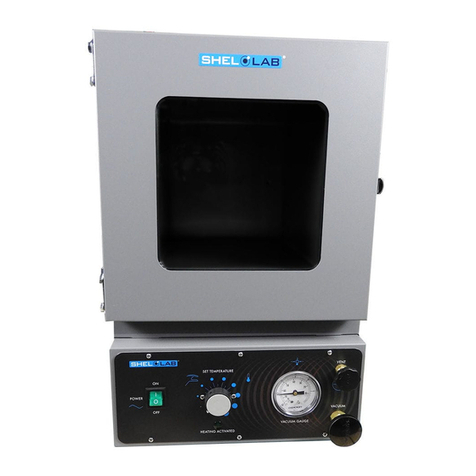
shelolab
shelolab SVAC1E User manual
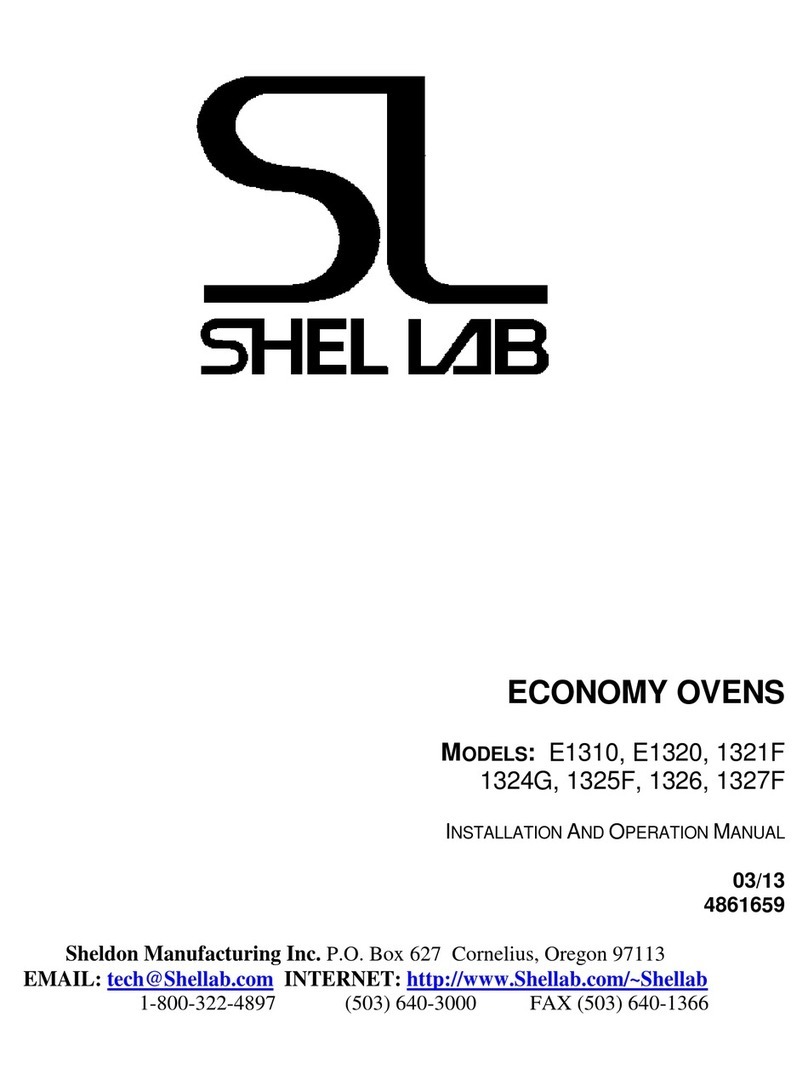
shelolab
shelolab E1310 User manual
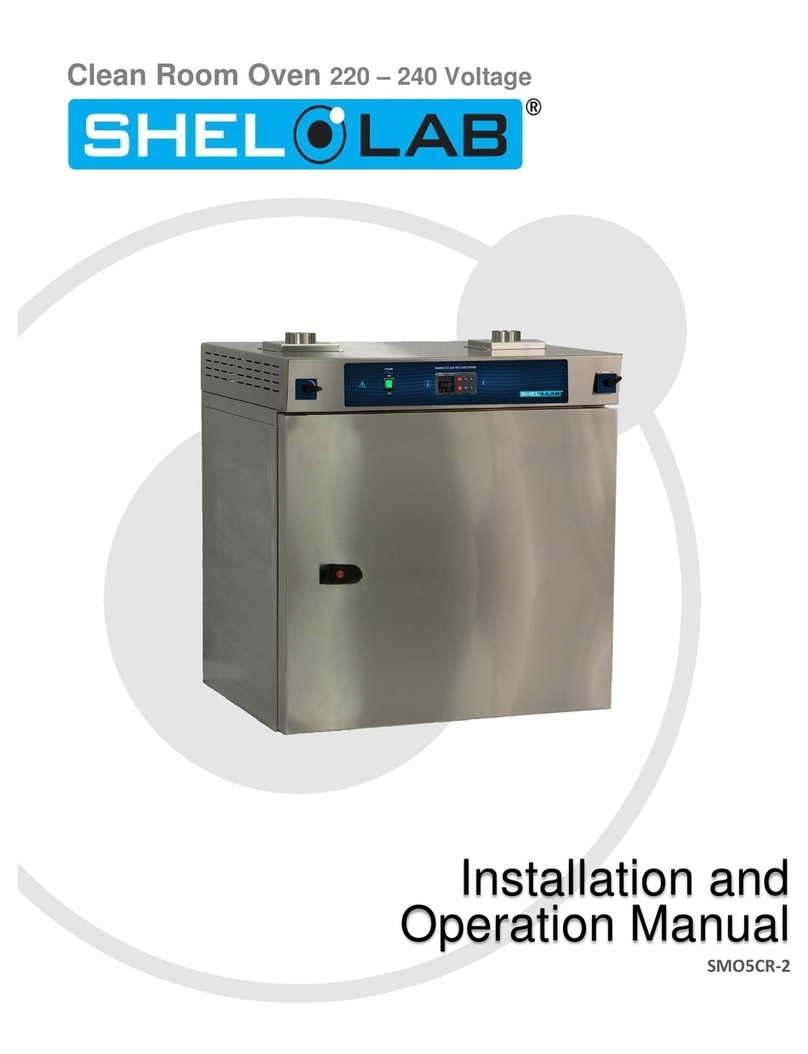
shelolab
shelolab SMO5CR-2 User manual
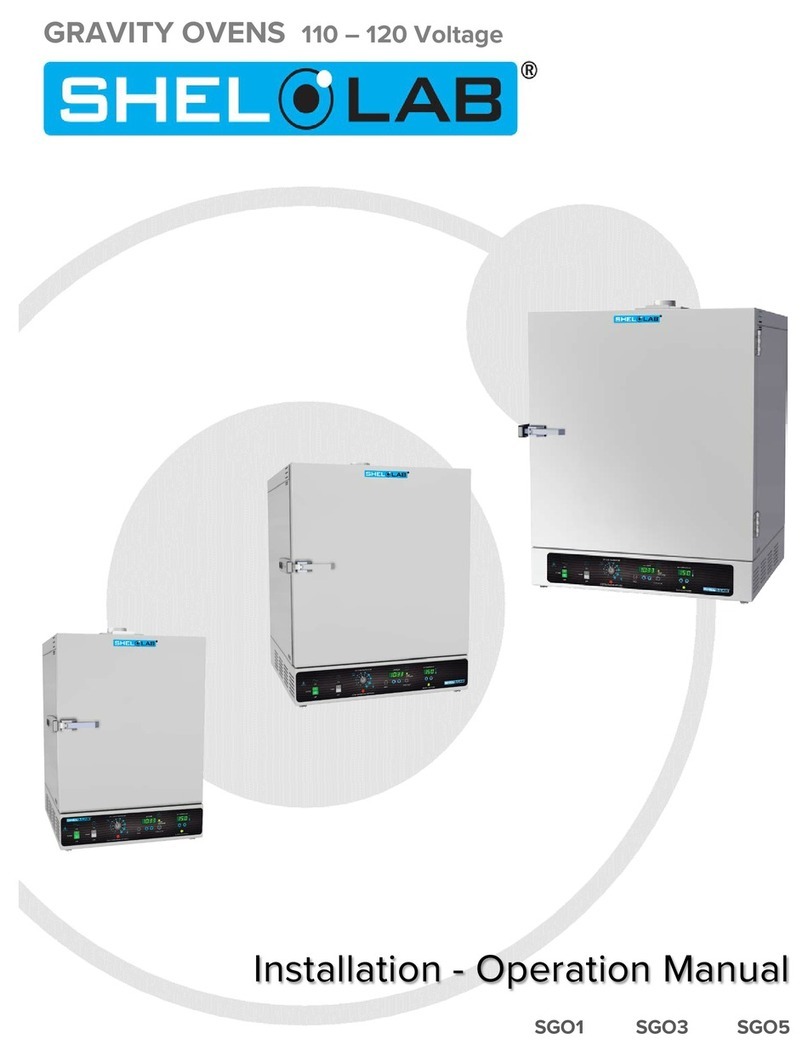
shelolab
shelolab SG02 User manual
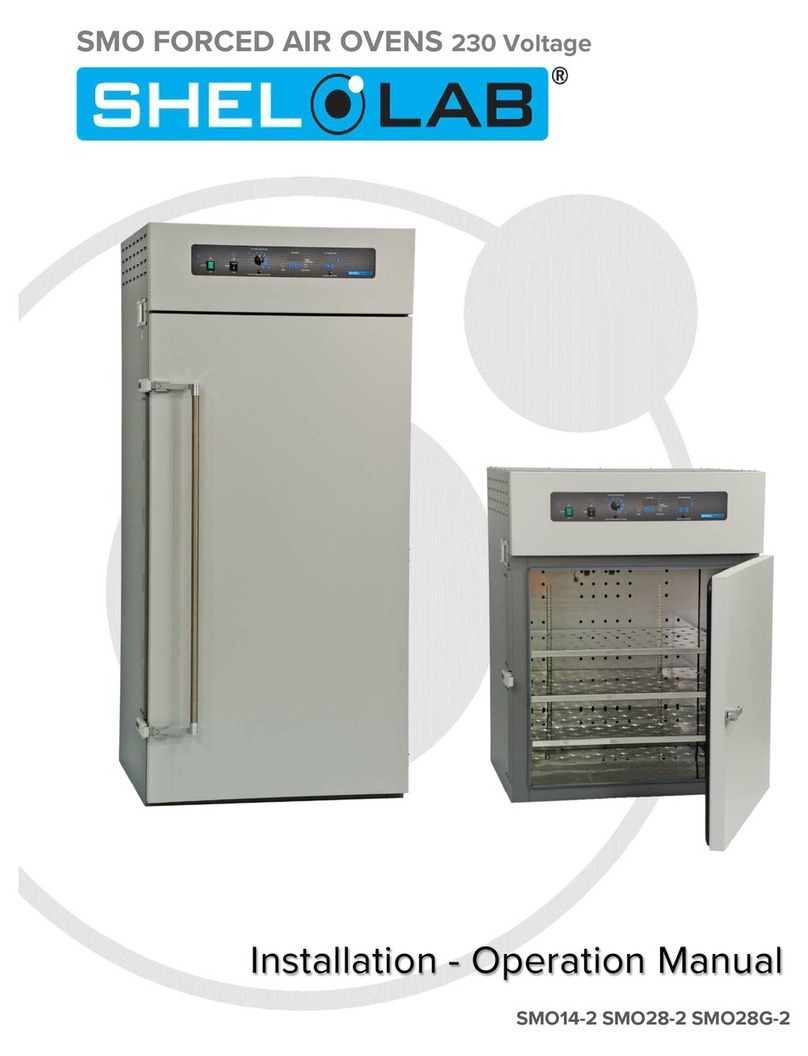
shelolab
shelolab SMO14-2 User manual
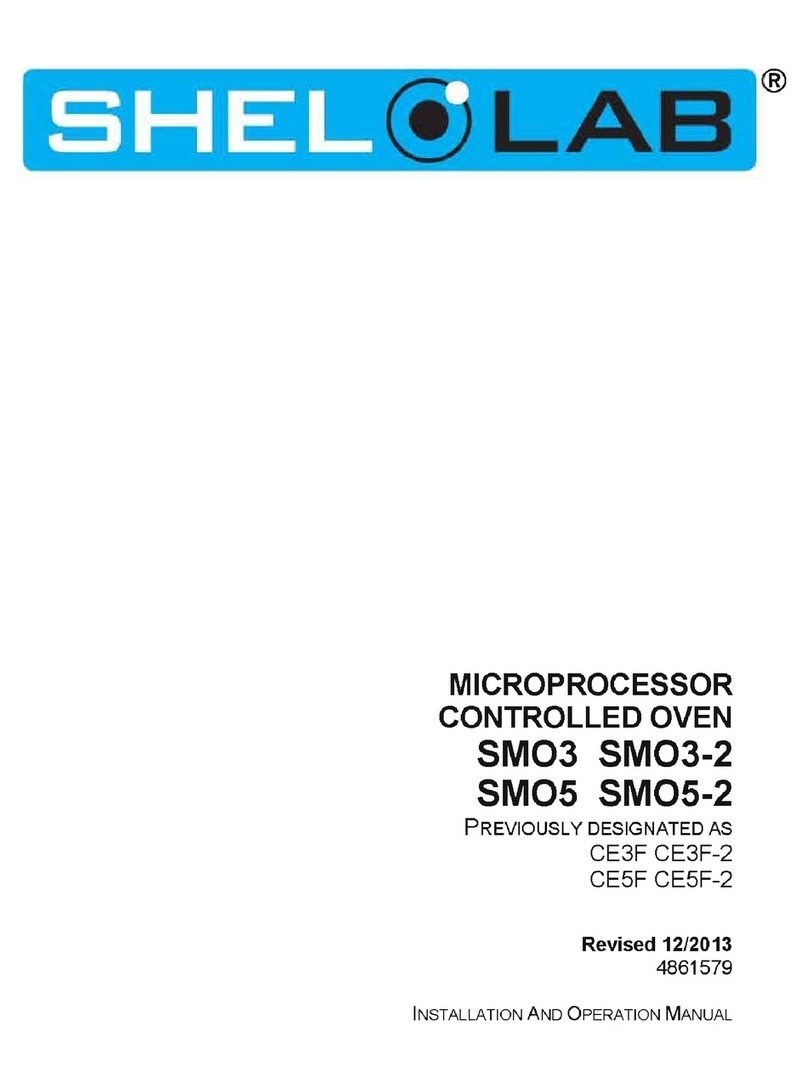
shelolab
shelolab SMO3 User manual
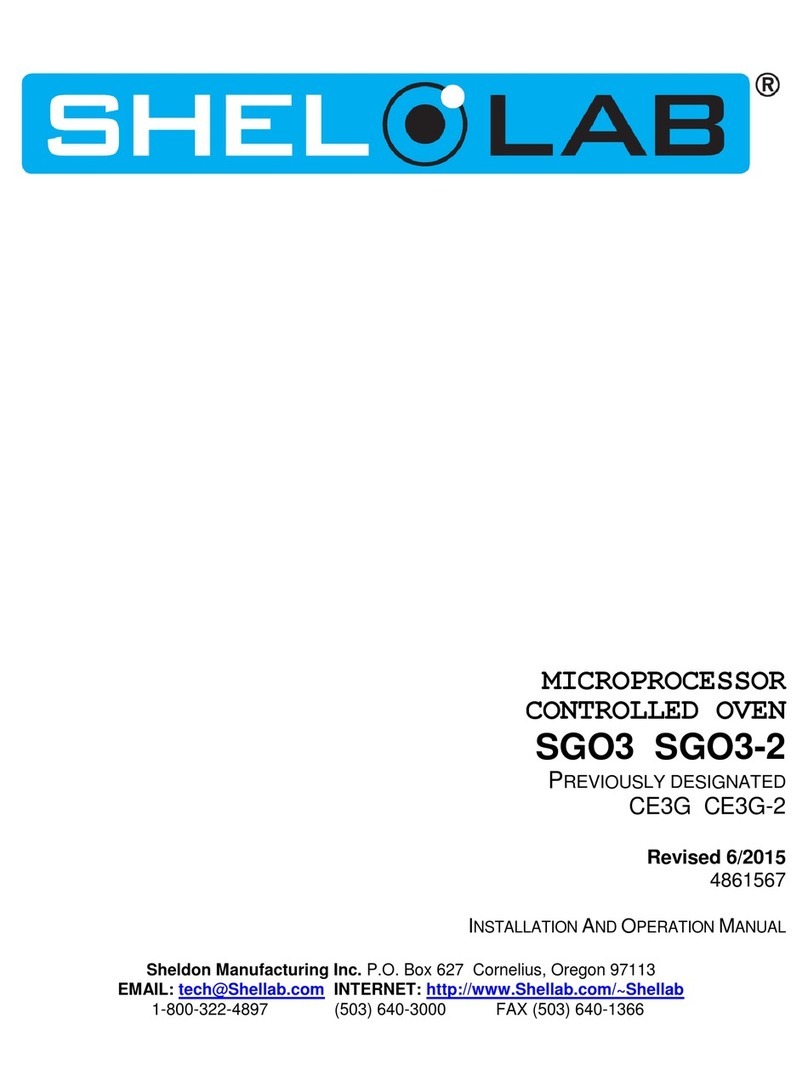
shelolab
shelolab SGO3 User manual
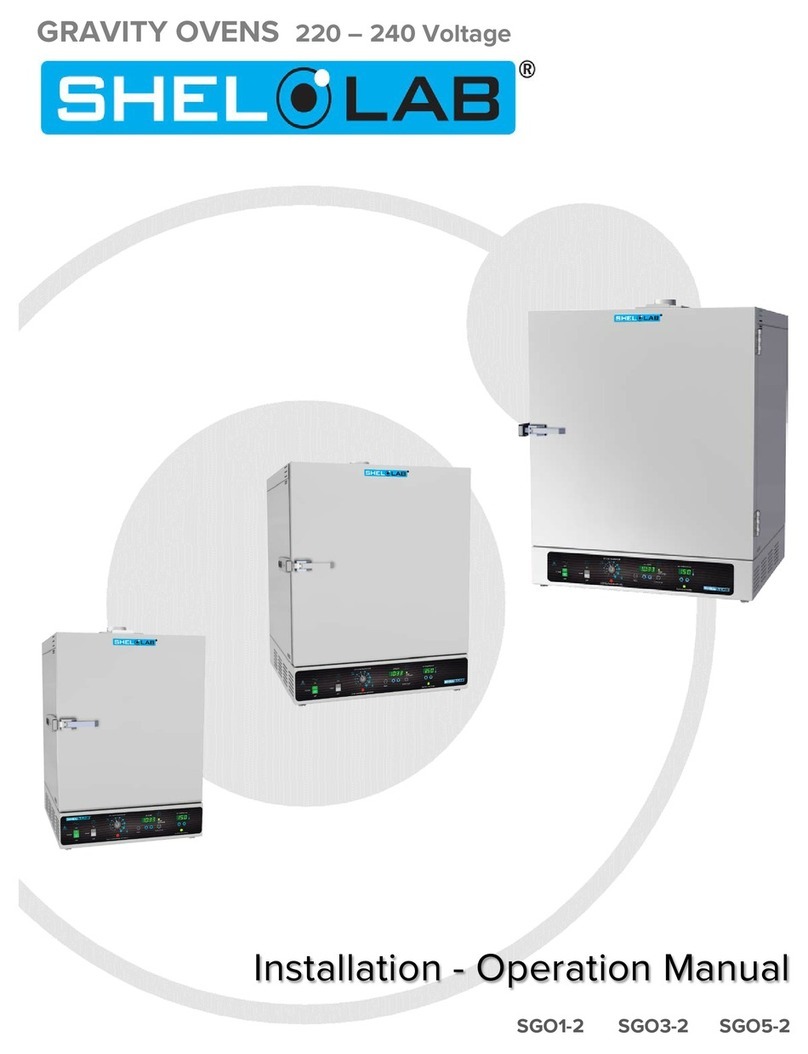
shelolab
shelolab SGO1-2 User manual
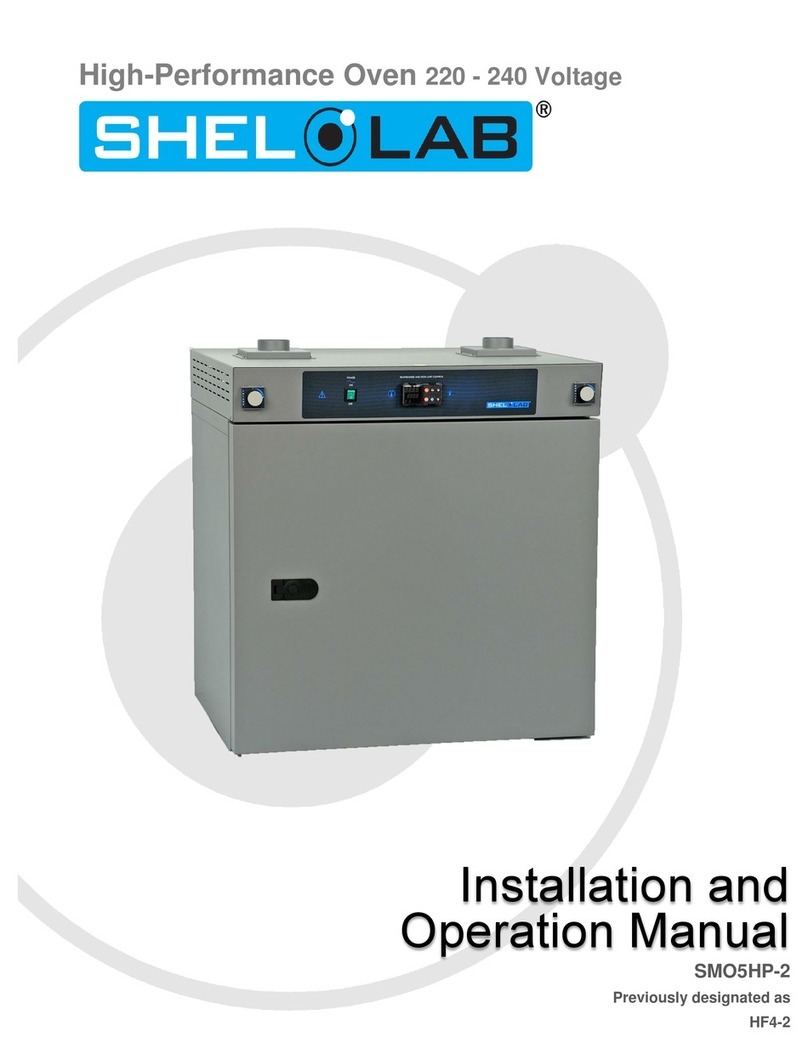
shelolab
shelolab SMO5HP-2 User manual
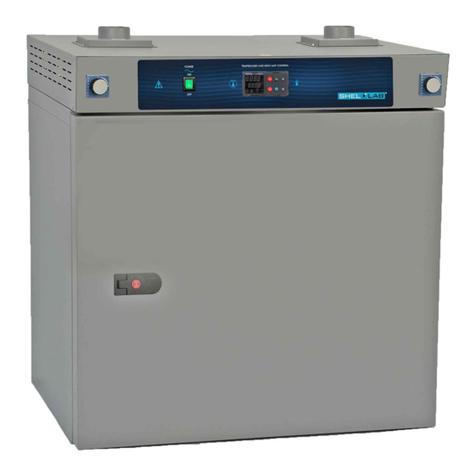
shelolab
shelolab SMO5HP-2 User manual
Popular Oven manuals by other brands

TurboChef
TurboChef HHB-8028 Service manual
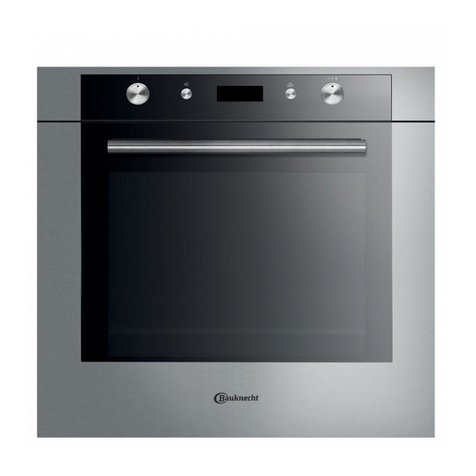
Bauknecht
Bauknecht BCVM 8100 User and maintenance manual

Moffat
Moffat WALDORF RN8510GE Technical data sheet
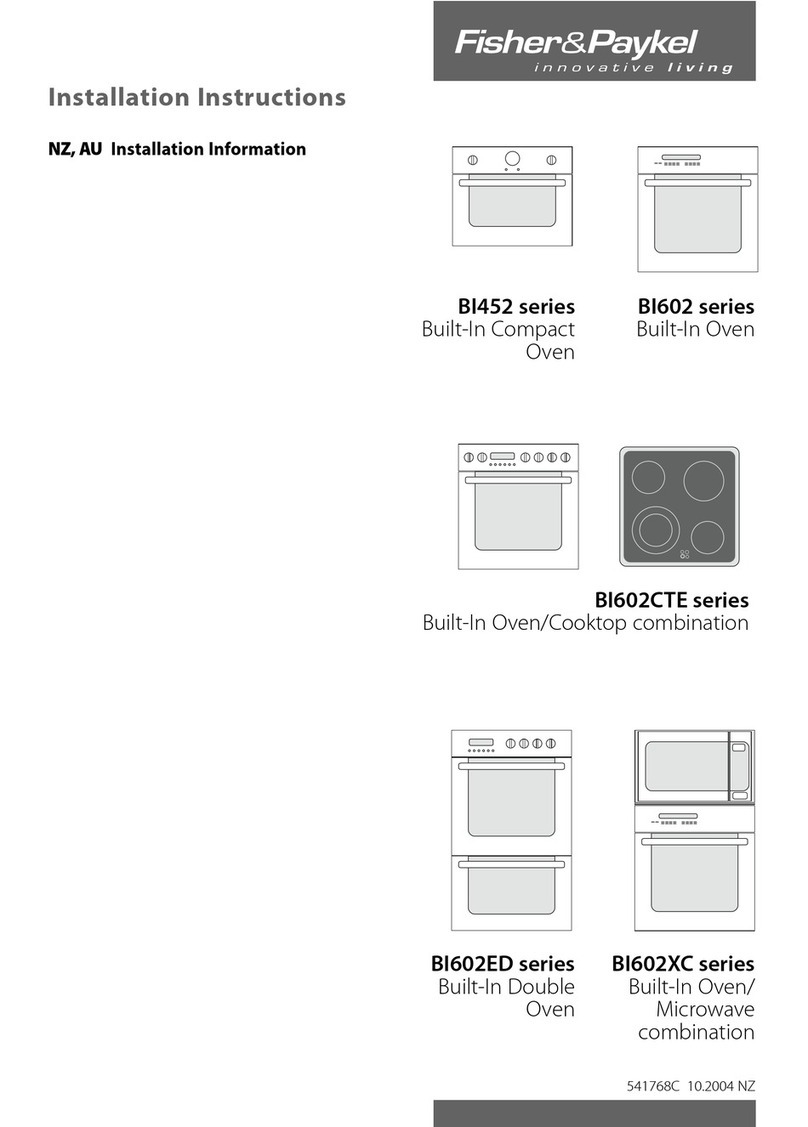
Fisher & Paykel
Fisher & Paykel BI452 Series installation instructions
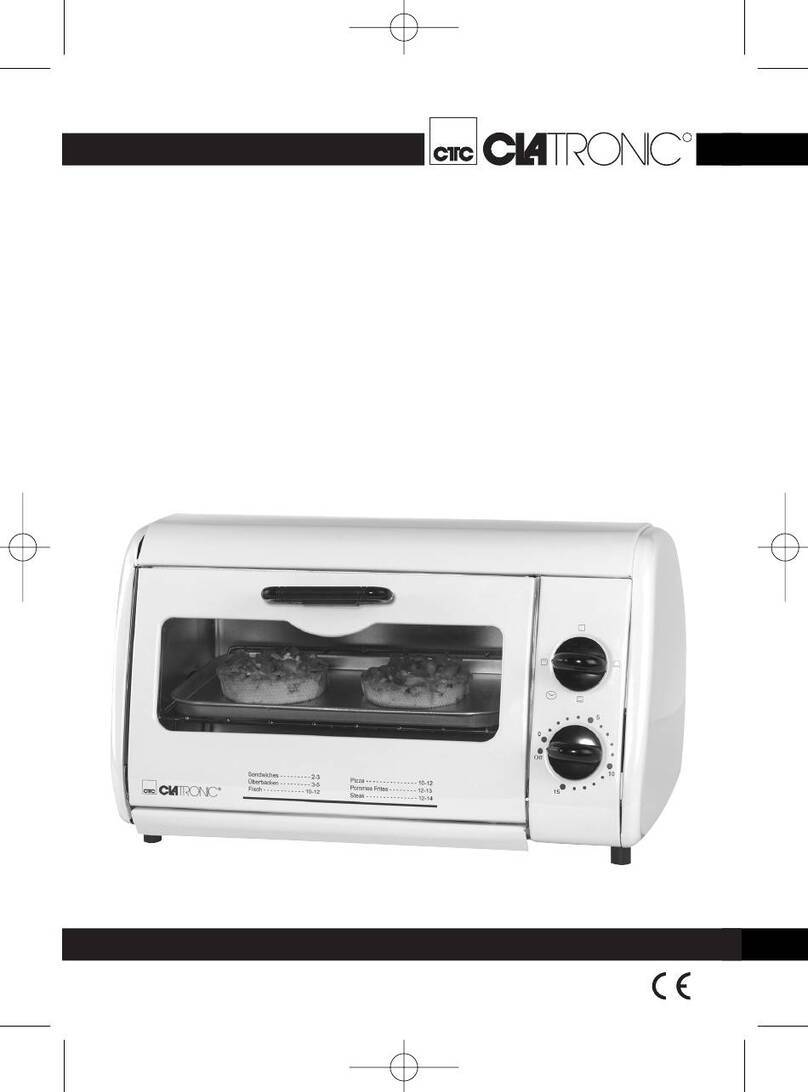
Clatronic
Clatronic MB 2789 instruction manual
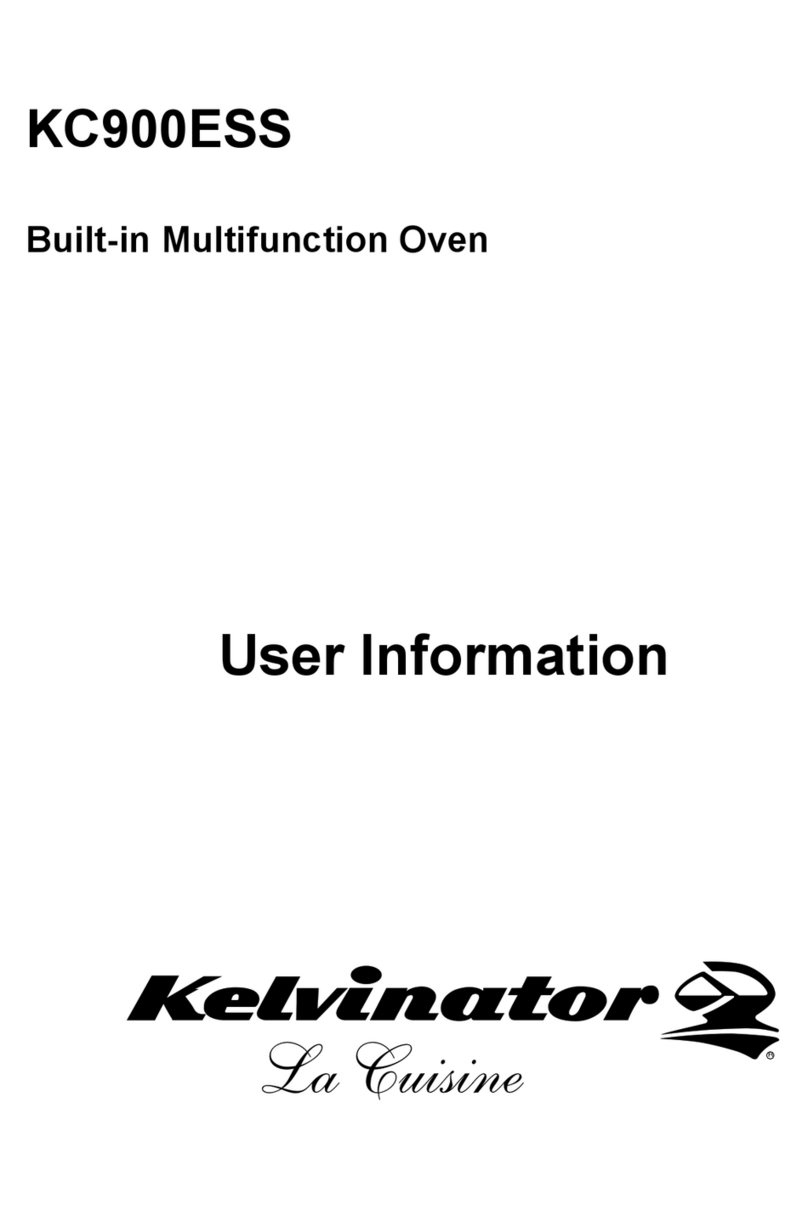
Kelvinator
Kelvinator KC900ESS User information


